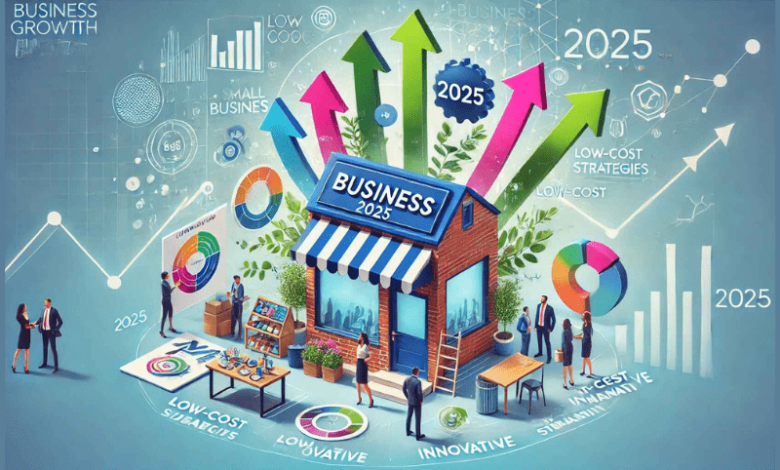
As we progress into 2025, firms in every sector are encountering ever-shifting financial conditions. The introduction of new technologies, such as AI, in addition to changing compliance policies and regulations will determine how businesses plan today what they chose to succeed in tomorrow. In this piece, we will analyze the most recent trends in business growth strategies and provide data-driven recommendations with practical examples that will help your business prosper in and after 2025.
1. The Rise of Artificial Intelligence in Business Growth Strategies
AI moved from the realm of science fiction to becoming a crucial part of a business strategy’s framework. It is redefine entire sectors by boosting productivity and critical thinking, while also performing multiple functions. Organizations that are geared towards AI focused growth are already witnessing growth in their operational metrics, service delivery, and even costs.
Case Study: Amazon’s AI-Enhanced Logistics
Amazon might have been at the forefront of AI adoption. Its logistics and inventory processes have been transformed by machine learning, furthermore, minimizing cost and speeding up delivery. Businesses deploying AI in their supply chain stand to gain 15-20% operational efficiency improvement according to a McKinsey Report.
How and Why it Works
AI makes it easier for companies to process massive amounts of data, spot analytics, and make decisions in real-time. For instance, AI-powered solutions can forecast customer needs which enables companies to modify stock levels. This helps in cutting down waste and increasing profits.
Tactical Moves:
- Invest on AI Infrastructure: Construct or collaborate with AI tech companies.
- Concentrate on Insight Driven by Data: Leverage AI to gather and analyze customer and operational data.
- Ethics of AI Use: Follow accepted industry guidelines and laws regarding the use of AI with regard to disclosure.
2. The AI Powered Business Model – Cybersecurity As the Foundation of Strategy
Cybersecurity is now more crucial than ever as businesses have shifted to online platforms. As AI and data analytics becomes more ingrained in organizations, the possibility of cyber threats also increases. Protecting sensitive information and risk management are important dimensions of business strategy in this era.
Example: Equifax Data Breach
The Equifax data breach in 2017 which leaked data of 147 million Americans is a perfect example for the need of strong cybersecurity policies in place. Organizations that do not put in place data security measures expose themselves to huge financial losses and reputational harm.
How and Why It Works:
The digitization of transactions and the use of cloud technology has left businesses exposed to a greater range of cyber threats. As a breach can cause loss of customer trust and result in non-compliance with GDPR and CCPA regulations, having a comprehensive cybersecurity measure in place is imperative.
Strategic Actions:
- Invest in Multi-Layered Security: Incorporate encryption, firewalls, and AI-based monitoring systems.
- Conduct Regular Security Audits: Identify gaps and correct them immediately.
- Ensure Employee Training: Staff should be well-versed with phishing and ransomware as well other common cyber-attacks.
3. Incorporating Sustainability in Corporate Strategy
Companies can no longer ignore sustainability as it has become a business need. Firms focusing on ESG are not only appealing to the socially responsible investors but are also improving their operational efficiency and cost-effectiveness.
Real-Life Case: Tesla’s Sustainable Business Model
Tesla is the best-case scenario of a company that organizes its business strategy around sustainability. Tesla has developed a loyal customer base and increased its market capitalization by focusing on electric vehicles and renewable energy products. Since 2020, the company’s stock price has increased over 500%, which speaks to the strong financial performance from a sustainability-focused business strategy.
How and Why It Works:
Using sustainable operational practices can reduce costs like energy efficiency expenditures while simultaneously increasing brand loyalty which results in sales revenue growth. A growing number of investors prefer companies with strong ESG policies, and a business’s commitment to sustainability turns out to be an important factor for consumers when making purchasing decisions.
Strategic Actions:
- Move Toward Renewable Energy Sources: Shift to solar, wind, and other eco-friendly energy sources.
- Emission Reduction Focused Waste Minimizing Practices: Recycling and waste reduction, including cutting emissions, at manufacturing sites.
- Publish ESG Reports: Publish progress documents responsive to ESG criteria on a regular basis.
4. Making Business Decisions Using Data Analytics
Strategic advantage requires decision making that is based on data. Advanced analytics systems are becoming more popular business tools as they are capable of processing huge amounts of data and uncovering valuable information about market dynamics, customer segmentation, and operational bottlenecks.
Real-World Example: Walmart’s Predictive Analytics
The company uses predictive analytics to manage inventory and forecast demand. Walmart’s capacity to reduce excess stock and improve product availability saves the company over 1 billion dollars in inventory costs every year.
Its Working Principles’ Characteristics:
Analytical data systems describe the systems which provide information on customer’s needs, market operations and a business’s operational effectiveness. With advanced analytics, data driven decisions can be implemented which enhances organizational performance.
Strategic Actions:
- Invest in Data Infrastructure: Create systems and methodologies to capture and generate insights from data.
- Build Teams Skilled In Data Analysis And Interpretation: Form dedicated resource with capabilities to decipher and gain insights from the data.
- Leverage Machine Learning Algorithms: Create demand forecasting models with machine learning to optimize marketing and advertising strategies.
Key Metrics:
As McKinsey states, companies that adopt analytics witness a growth of 5-6% more than those that don’t. Retailers utilizing advanced predictive analytics achieve up to 20% reduction in stock outages.
5. Emergence of FinTech and Digital Finance
This is where business operations with customers undergoes a thorough change with innovations like mobile payments, blockchain and more which evolves the interaction process with clients and transaction management.
Real World Example: Payment Processing Solutions Offered By Stripe.
For small and large enterprises, Stripe makes and processes millions of transactions each day which allows them the easy integration of online instrument as well as provides tools for processing e-commerce platforms. Thus, Stripe offers enhanced flexibility in the manner that businesses are able to process payments online.
How and Why It Works:
FinTech solutions optimize financial transactions, minimize expenses, and increase overall openness. Implementing FinTech tools will offer opportunities to improve business processes, enhance customer satisfaction, ensure enhanced security, and unlock new streams of revenue.
Strategic Actions:
- Adopt FinTech Solutions: Use automated systems for payments or invoicing, and implement tools for crowdfunding.
- Explore Blockchain: Employ blockchain technology for secure and transparent record-keeping.
- Enable Digital Wallets and Payments: Allow customer payments through digital wallets such as Apple Pay and Google Wallet.
6. Supply Chain Diversification: A Key Strategy for 2025
As global disruption events – including the COVID-19 pandemic and geopolitical conflicts – persist, supply chain diversification has grown increasingly important. A single supplier or region creates an over-reliance that inherently increases risk; thus, diversification becomes a fundamental aspect of any business strategy today.
Real-World Example: Apple’s Supply Chain Strategy
Apple’s supply chain is well known for its active diversification strategies to reduce exposure to volatile suppliers. For instance, Apple has shifted some manufacturing to India and Vietnam to reduce dependence on China which diversifies political instability and trade tariffs risk.
How and Why It Works
The risk is minimized by having the supply chain diversified because production can be spread across different sponsors as well as diverse geographical regions. This allows a firm to deal with global issues without disrupting the supply of the products.
Strategic Actions:
- Diversify Supplier Base: Build connections with suppliers from various areas.
- Adopt Just-in-Time Manufacturing: Curb costs associated with holding stock by streamlining production.
- Use of Local Suppliers: Purchase materials from local suppliers to lessen dependence on international supply chains.
Conclusion
Strategically, businesses need to start working now to prepare to operate in 2025. The world is changing at a rapid rate exposing companies to countless risks these days and requires the implementation of robust, flexible, risk mitigating, and anticipatory strategies. Companies that continue to adopt more AI powered solutions alongside FinTech need to prioritize their cyber defenses and go green. Firms that opt to undertake these trends will stand to recommend competitive advantages. With these steps in combination with data-based actions and innovative technologies, the complex business climates can be braved over the upcoming years.
Related Topic:Utilizing Artificial Intelligence (AI) in Business Intelligence Strategic Advancement in 2025





